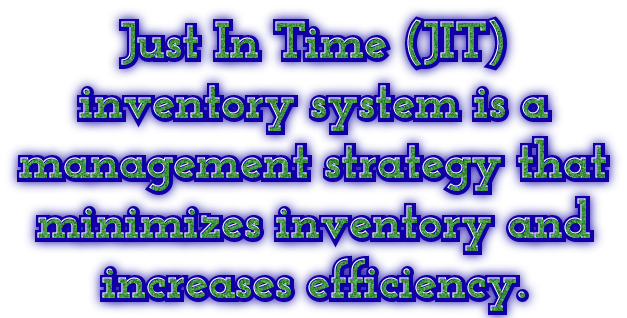JUST IN TIME (JIT)
Hello friends,Today, we will talk and discuss about a very modern concept in the field of manufacturing. It is also know as time manufacturing or lean manufacturing.
First of all, thanks for visiting.
Now, below topics that are covering today.
Now, below topics that are covering today.
- INTRODUCTION
- HISTORY
- ADVANTAGES OF JUST IN TIME (JIT)
- DISADVANTAGES
- 7 TYPES OF WASTES
- HOW TO APPLY JIT (Just InTime)?
INTRODUCTION:
As we know that, when we require raw material for the manufacture of any product. we purchase more than enough raw material and store its more quantity and collect it in the godown. Due to which, we may have to send back the remaining raw material after manufacturing or it may even get spoiled. On sending back the raw material, our transportation cost goes to extras and if the remaining Raw material gets spoiled, then our money on it gets wasted.
Just in time tells us that raw material for manufacturing the product should be procured only when the demand of the customer is in your hands. That is, we should purchase raw material only after the customer's requirement. According to the need, we have to take raw material.
 |
Just In Time manufacturing strategy is that, when companies get customer's demand, they buy the raw material according to the need, otherwise not.
Definition:
It is an inventory management system which is used to manage the stock that is kept.
 |
| Finished goods barcode management system |
FG Barcode management system:-
In this, A scanner device using for scanning barcode, this device is integrated with a software based application and used for auto process for our FG parts transfer to our system in actual number of parts. It makes auto invoicing for customer by using barcode scanning system. This system is a game changer for our organization. All inventories are controlled by this. This is make sure that product sent to customer at right time, right quantity and right location. It avoid also customer concerns like wrong part supply, wrong label and supply delay etc.
It involves receiving good from the suppliers as and when required and rather than carrying a large inventory at once. Companies used this inventory strategy to increase efficiency and reduce wastage, so that the manufacturing process could only receive goods as needed which reduce inventory cost. This method requires procedure of focus demand accurately.
This strategy is also called Toyota Production System (TPS) because it was developed by Toyota in Japan. This strategy was first used by Toyota in 1970s and it gave them good results in manufacturing journey.
Just In Time (JIT) is also known by different name in different companies:
- Lean Manufacturing
- Just In Time
- Toyota Production System
- Lean Production
- Synchronous Manufacturing.
HISTORY:
- In 1960s, Taichi Ohno and his colleagues developed the Toyota Production System.
- In 1970s, the U.S. and European auto manufacturers began implementing the JIT strategy to improve quality and productivity.
- In 1990s and beyond: JIT strategy was adopted by manufacturers to streamline all types of operations.
ADVANTAGES OF JUST IN TIME (JIT):
- Less space needed
- Reduce inventory
- Reduce wastage
- Smaller investment
- Healthy cash flow
- Involve both supplier and customer to eliminate non value added activity.
- Improve quality and productivity.
DISADVANTAGES:
- Risk of running out of stock
- Lack of control over time frame
- More planning required
- Little room for mistake
The aim of JIT strategy us to eliminate the wastage and continuous improvement in productivity.
JIT (Just In Time) can't be implemented without eliminating or reducing seven deadly wastes from the manufacturing process. So in order to apply JIT, seven deadly wastes have to be eliminated from the process.
On seven wastes, in the previous concept 3M (Muda, Mura, Muri) was discussed as seven types of Muda.
You can read this concept by clicking the link above.
7 TYPES OF WASTES:
- Defect
- Overproduction
- Waiting
- Non-utilized talent (New)
- Transportation
- Inventory
- Motion
- Extra processing
HOW TO APPLY JIT (Just In Time)?
There are some important points that if applies in processes, then it is possible to implementing the JIT (Just In Time) strategy.
These points are below:
- Develop people: increase skills, productivity, morale
- Eliminate waste in all areas
- Optimize material handling and production flow
- Control tooling
- Increase quality
- Continously improvement.
You will understand this hopefully.
Thank you.
Thank you.
Some of related question that help to improve your basic knowledge.




No comments:
Post a Comment